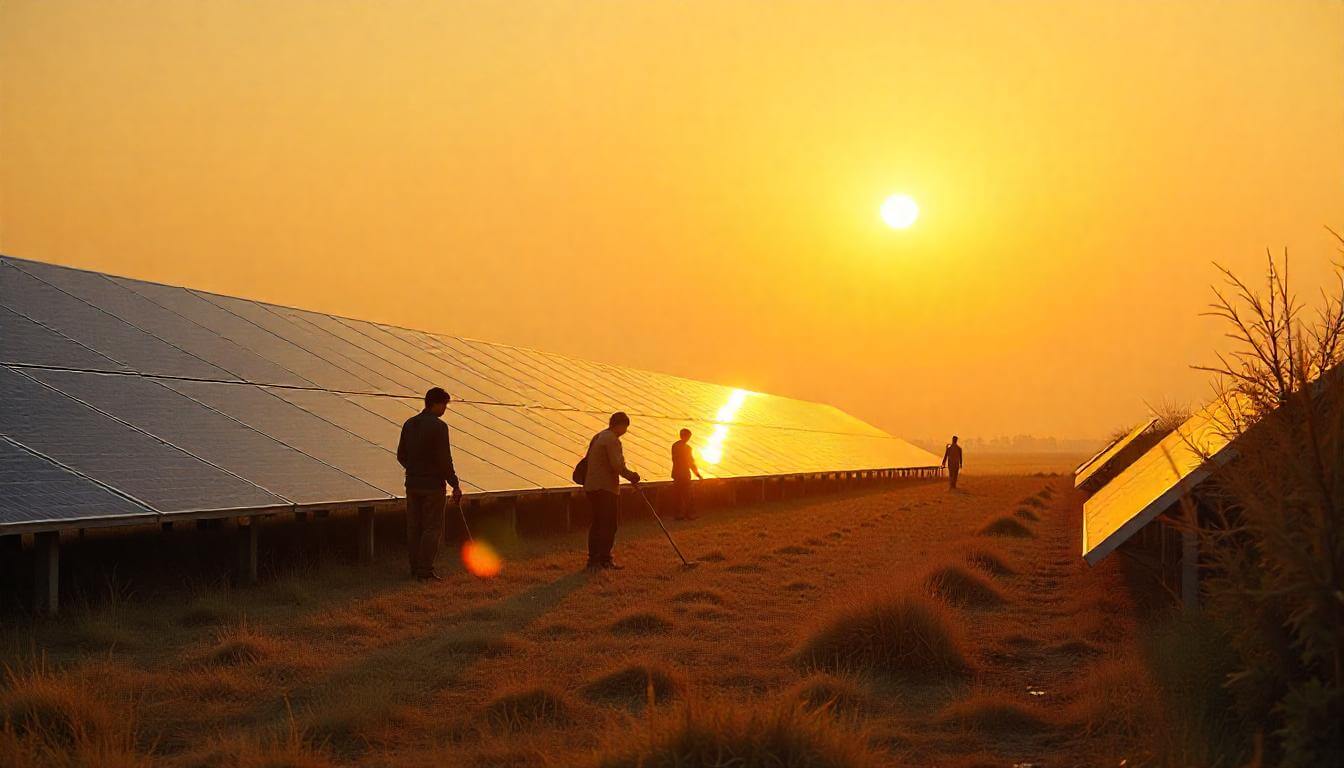Asia’s energy landscape is undergoing a profound transformation. Rapid economic growth fuels an ever-increasing demand for power. Simultaneously, the imperative to combat climate change drives a shift towards sustainable sources. In this dynamic environment, a significant $85 million clean energy fund is making waves. This substantial investment specifically targets the scaling of solar power across the vast Asian continent. This article will examine this crucial transaction (over $50 million), exploring its mechanisms and far-reaching impact on the region’s renewable energy future.
Asia’s Energy Imperative: Growth Meets Sustainability
Asia stands at the forefront of global energy consumption. Its burgeoning economies and large populations necessitate enormous power supplies. Traditionally, fossil fuels have met much of this demand, leading to significant environmental challenges. However, a growing awareness of climate change, coupled with declining costs of renewable technologies, has accelerated a paradigm shift. Nations across Asia are now setting ambitious targets for decarbonization.
Therefore, robust investment in clean energy is not merely an environmental choice; it is an economic necessity. Governments and private entities recognize solar power’s immense potential. It offers a decentralized, scalable, and increasingly cost-effective solution. Achieving widespread solar adoption requires substantial capital infusion, which is precisely where dedicated funds like this new $85 million initiative play a vital role.
The Role of a Clean Energy Fund in Market Acceleration
A clean energy fund operates as a critical financial instrument. It mobilizes capital specifically for renewable energy projects and companies. Such funds can take various forms, including private equity, venture capital, or blended finance vehicles. Their primary goal involves identifying promising ventures. They also provide the necessary financial backing to bring these projects to fruition or help companies scale.
Furthermore, these funds often offer more than just capital. They provide strategic guidance. They also connect portfolio companies with vital industry networks. In Asia, where regulatory frameworks and market conditions can vary widely, this expertise is invaluable. A well-structured clean energy fund mitigates risks for investors. It also accelerates the deployment of sustainable energy solutions, acting as a powerful catalyst for market transformation.
Unpacking the $85 Million Clean Energy Fund: A Strategic Overview
This particular $85 million clean energy fund represents a concerted effort to accelerate solar deployment across key Asian markets. While specific fund managers and target companies often remain undisclosed for competitive reasons, the scale of this investment indicates a focus on high-impact projects. The fund likely targets ventures across the solar value chain. This includes utility-scale solar farms. It also extends to distributed rooftop installations. It may even include innovative solar technologies like floating solar or agrivoltaics.
The capital will primarily support development, construction, and operational phases. It will also facilitate expansion into new geographical areas within Asia. Fund managers will conduct rigorous due diligence, assessing both financial viability and environmental impact. This strategic allocation of $85 million will unlock substantial solar capacity, contributing directly to Asia’s clean energy goals. It underscores a growing trend of significant capital flowing into the region’s renewable sector.
Scaling Solar Across Asia: Addressing Key Challenges
Scaling solar power across Asia presents unique challenges. Land availability can be an issue in densely populated areas. Grid infrastructure sometimes struggles to integrate intermittent renewable sources. Policy frameworks, moreover, vary significantly from country to country. Overcoming these hurdles requires innovative approaches and substantial investment.
This $85 million clean energy fund directly addresses some of these challenges. It can finance projects that employ advanced grid integration technologies. It can also support the development of energy storage solutions, ensuring grid stability. Furthermore, the fund may back companies specializing in modular or decentralized solar solutions. These are ideal for remote communities. By providing targeted capital, the fund helps de-risk projects. It also attracts further private investment, fostering a more robust solar ecosystem across Asia.
Impact on Energy Access and Economic Development
The scaling of solar power, driven by this clean energy fund, has profound implications for energy access. Millions in Asia still lack reliable electricity. Solar mini-grids and off-grid solutions offer a viable path to electrification. This fund can finance such initiatives, bringing power to underserved populations. Access to electricity, in turn, fuels economic development. It supports small businesses. It also improves education and healthcare facilities.
Moreover, local communities benefit from job creation. The construction, operation, and maintenance of solar projects generate employment opportunities. This fosters local economic growth. It also builds a skilled workforce in the green energy sector. The reduction in reliance on expensive, imported fossil fuels also strengthens national economies. It improves energy security. Ultimately, this investment contributes to both environmental sustainability and socio-economic progress across the continent.
Technological Advancement and Innovation Catalysis
Beyond direct deployment, this clean energy fund will catalyze technological advancement. Investment often flows into companies developing next-generation solar technologies. These include more efficient photovoltaic (PV) materials. They also encompass advanced inverter systems. Furthermore, they involve smart grid software for optimal energy management.
The fund’s strategic capital can accelerate the commercialization of these innovations. It allows companies to move from research and development to large-scale manufacturing and deployment. This continuous innovation is crucial. It ensures solar power remains competitive. It also drives down costs further. Therefore, the $85 million investment not only scales existing solutions; it also fosters the development of future breakthroughs. This ensures Asia remains at the forefront of solar technology.
Regional Trends and the Future Outlook for Solar in Asia
Asia is already a global leader in solar deployment. Countries like China and India boast immense installed capacities. Southeast Asian nations are rapidly increasing their solar footprints. Investment trends indicate continued exponential growth. This $85 million clean energy fund aligns perfectly with these regional dynamics. It capitalizes on existing momentum. It also helps overcome remaining barriers.
The future outlook for solar in Asia remains exceptionally bright. Governments are committed to renewable energy targets. Technological advancements continue to drive efficiency and reduce costs. Internationale Zusammenarbeit und strategische Investitionen werden die Einführung weiter beschleunigen. Die Wirkung dieses Fonds wird wahrscheinlich über sein direktes Portfolio hinausgehen. Er wird zu weiteren Investitionen anregen. Er wird auch als Vorbild für ähnliche Initiativen dienen und Asiens Position als Kraftwerk für erneuerbare Energien festigen.
Die Rolle des Privatkapitals beim nachhaltigen Wandel
Privatkapital spielt eine unverzichtbare Rolle bei der globalen Energiewende. Öffentliche Mittel und Entwicklungsbanken bilden die Grundlage für die Unterstützung. Der schiere Umfang der erforderlichen Investitionen erfordert jedoch eine erhebliche Beteiligung des Privatsektors. Dieser mit $85 Millionen ausgestattete Fonds für saubere Energie ist ein Beispiel für diese Zusammenarbeit. Er zeigt, wie privates Kapital effektiv in wichtige Bereiche der nachhaltigen Entwicklung fließen kann.
Solche Fonds verwenden häufig gemischte Finanzierungsstrukturen. Sie kombinieren öffentliche, philanthropische und private Ressourcen. Dieser Ansatz trägt dazu bei, das Risiko von Investitionen zu verringern. Er zieht auch ein breiteres Spektrum von Investoren an. Letztendlich wird der erfolgreiche Einsatz dieses Fonds die finanzielle Attraktivität sauberer Energien verdeutlichen. Dies wird mehr private Investoren zur Teilnahme ermutigen. Diese synergetische Beziehung zwischen öffentlicher und privater Finanzierung ist der Schlüssel zum Erreichen ehrgeiziger Klimaziele.
Schlussfolgerung: Asien mit Solarstrom versorgen
Die $85 Millionen clean energy fund ist auf dem besten Weg, eine enorme Wirkung zu erzielen. Sie wird die Verbreitung der Solarenergie in ganz Asien beschleunigen. Diese strategische Investition dient der Deckung des kritischen Energiebedarfs. Außerdem werden damit dringende Umweltprobleme angegangen. Durch den Einsatz von umfangreichem Kapital und Know-how trägt der Fonds zum Zugang zu Energie bei. Sie fördert die wirtschaftliche Entwicklung. Sie treibt auch die technologische Innovation voran. Diese Initiative ist mehr als nur eine finanzielle Transaktion. Sie steht für ein starkes Engagement für eine nachhaltige, solarbetriebene Zukunft in Asien. Sie unterstreicht die entscheidende Rolle gezielter Investitionen für das Erreichen der globalen Energiewendeziele.

 Der $85M-Fonds für saubere Energie: Ausbau der Solarenergie in ganz Asien">
Der $85M-Fonds für saubere Energie: Ausbau der Solarenergie in ganz Asien">

Kommentare